
It’s time to throw my great-grandmother under the bus.
I have a good reason, though. She gave me an amazing case study showing how NOT to analyze a historical document — and helps answer this frequent question:
How can I know if a historical document is about my ancestor?
We’ll use this case study to discover 3 tips to save you time when reviewing a historical document about your family tree.
In the 1970s, my great-grandmother Mimi was researching her great-grandfather Daniel Moore.
“I have documents showing” various facts about Daniel Moore, Mimi wrote. Such as:
- Birth: October 17, 1809 in Kentucky
- Married: Maria Olney in September 1840 in Iowa
- Died: 1891 in Chicago at age 82
- Occupation: He was a farmer and ran a small store
For the sake of this case study, we’ll take those facts as being true and well documented.
Enter the historical document — a death certificate
In 1974, Mimi received Daniel Moore’s death certificate from the State of Illinois. Here it is:
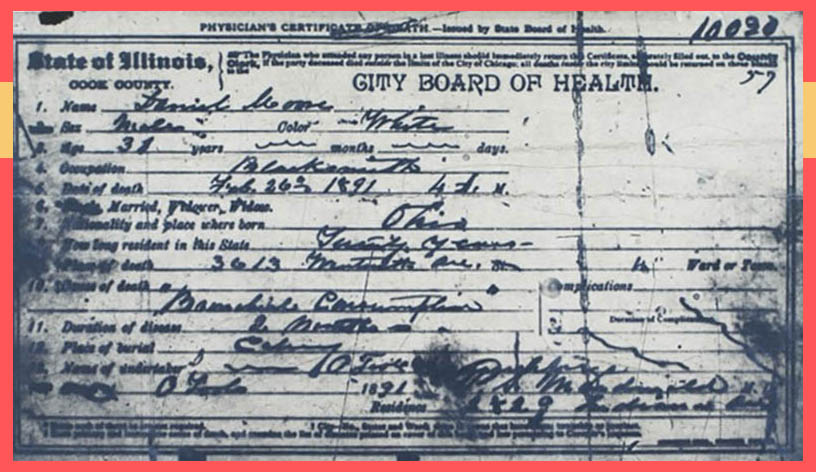
She noticed differences between this historical document and the info she already knew about Daniel Moore.
So she made some comments. On the death certificate. And when she ran out of room on the front, she flipped the page over, and continued. Like this:
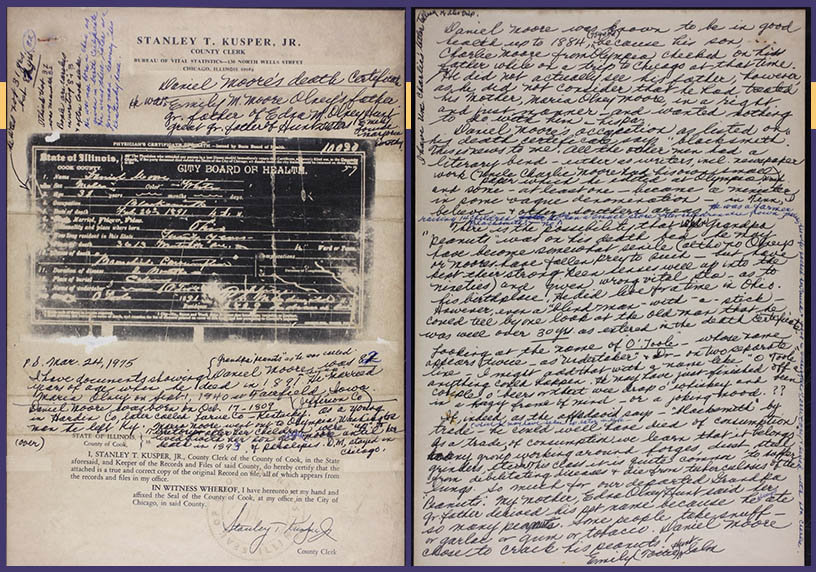
All that handwriting is hers. It’s her analysis of the historical document. And it offers fantastic insight into her thinking.
Let’s go through it now.
(BTW — I inverted the color on the death certificate close ups so it would be easier for you to read. That’s why the death certificate portion on the image with Mimi’s notes is black.)
Difference #1 — Ages
The pink highlight shows Daniel Moore’s age stated as 31 years.
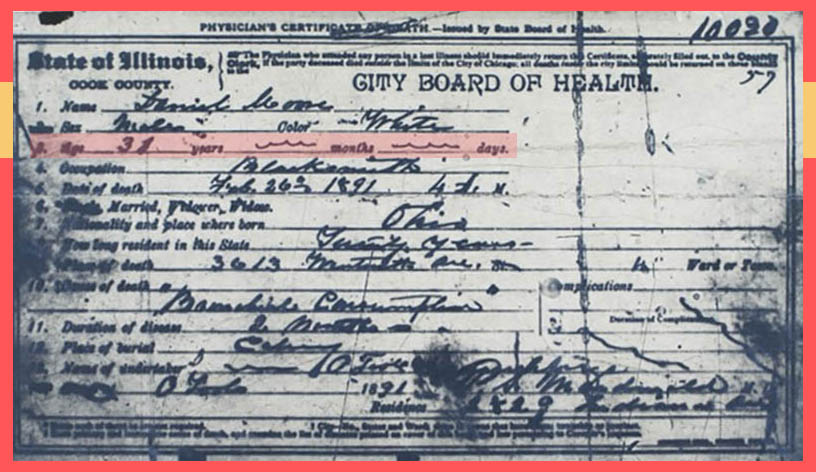
Mimi’s other documents told her that Daniel Moore should have been 82 when he died in 1891.
That’s a 51-year discrepancy. But Mimi had an explanation:
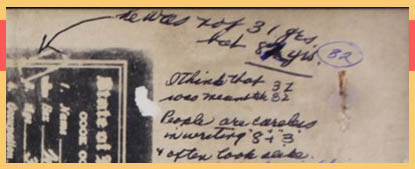
Here’s the transcription: “He was not 31 years but 82 years. I think that 31 was meant to be 82. People are careless in writing ‘8’ and ‘3’ and often look alike.”
And she wasn’t done trying to figure out why there was an age discrepancy. Here’s her second note:

First off, she recognizes that anyone should be able to see that a 90-year-old man is not 30 years old.
“Looking at the name of O’Toole,” Mimi ponders about the doctor who signed the death cert, “anything could happen. He may have just finished off a couple o’ beers or that wee drop o’ whiskey and been in a hazy frame of mind — or a joking mood??”
In other words — the Irish doctor must have been drunk and put the wrong age on the death certificate. 🍻🍀
Difference #2 — Places of birth
The death certificate gave Daniel Moore’s place of birth as Ohio.
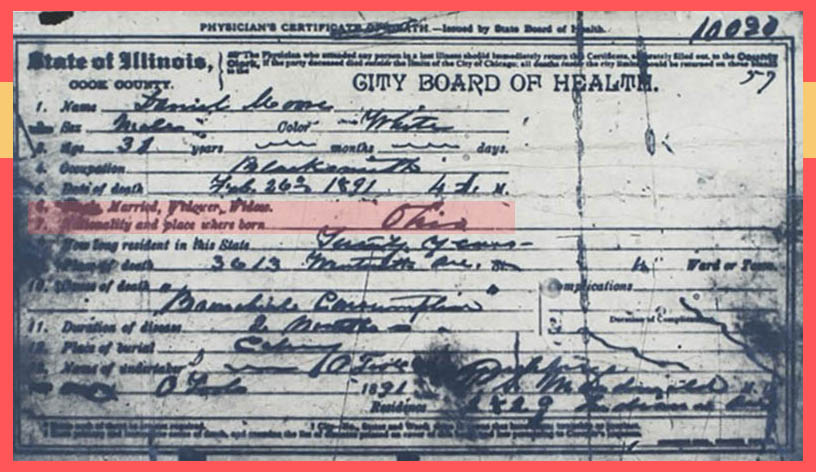
Except . . . well, Mimi had information that Daniel Moore was born in Kentucky.
So, why the difference? Here’s Mimi’s answer:

“There is the possibility that when [Daniel Moore] was on his death bed he may have become somewhat senile . . . and given wrong vital [information] as to his birthplace. He did live for a time in Ohio.”
So old Daniel Moore had dementia and told the drunk, Irish doctor the wrong place of birth.
A person with dementia providing incorrect info could be a reasonable conclusion, although this historical document doesn’t give us clues to who gave Mr. O’Toole information about Daniel Moore. It could have been Daniel himself. It could have been another relative or friend. Dementia isn’t a conclusion I’d quickly jump to.
Difference #3 — Occupations
Daniel Moore was a farmer and, at some point, owned a small store, according to what Mimi knew.
But, once again, the historical document differs — showing Daniel Moore was a blacksmith.
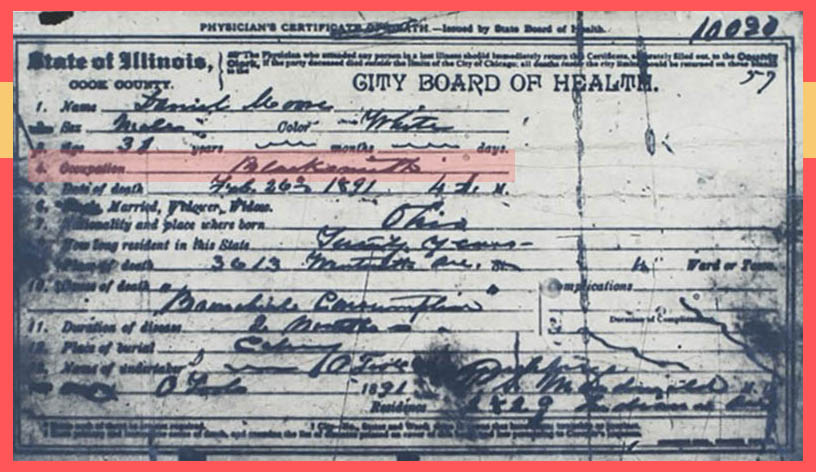
Mimi took exception to this. Not only did she know Daniel Moore was a farmer, but blacksmithing was . . . well, here’s her words:

“This is news to me. All the other men [in Mimi’s family] had a literary bend — either as writers, incl. newspaper work . . . and some — at least one — became a minister in some vague denomination.”
A blacksmith! Oh, the horror and embarrassment. Hope she doesn’t learn that my husband does blacksmithing. Or that her other great-grandfather was a teamster . . . 😲😈
Determine if a historical document is about your ancestor
Let’s compare what Mimi knew with what the death cert told her about Daniel Moore:
Mimi’s info
- Birth: October 17, 1809 in Kentucky
- Married: Maria Olney in September 1840 in Iowa
- Died: 1891 in Chicago at age 82
- Occupation: Farmer and ran a small store
Death Cert
- Birth: around 1860 in Ohio
- Married: Yes, but we don’t know to whom (see line 6)
- Died: February 26, 1891 in Chicago at age 31
- Occupation: Blacksmith
The most basic rule of family history is to move from what you know to what you don’t know.
So . . . to tell if a historical document is about a specific person, start by comparing what you already know about that person to what the document tells you. If that information matches up, you could reasonably conclude the document is about that person. Then you’d move on to learning new information the historical document tells you.
Mimi’s analysis of Daniel Moore’s death certificate is NOT an example of this strategy.
The only thing that Mimi’s Daniel Moore and the death certificate Daniel Moore have in common is that they died in Chicago in 1891. Their ages, their birth years/places, and their occupations are completely different.
Conclusion — the death certificate examined here is NOT the death certificate of Mimi’s great-grandfather Daniel Moore. It’s likely for a different Daniel Moore.
So let’s examine 3 tips to save you time when determining if a historical document is about your ancestor.
Tip 1 — Don’t force a historical document to fit
Mimi forced the information in the death certificate to fit with what she already knew about Daniel Moore.
When information didn’t fit, she came up with explanations for why the document is wrong. “The doctor was drunk!” 🙄
If a historical document doesn’t fit in to what you already know about an individual, consider that it might not be about that person. Discard the doc completely or set it aside until you have more information to compare it with.
In this case, I’d toss out the death certificate. It’s 100% NOT the Daniel Moore who Mimi wanted to find.
Tip 2 — Research other possibilities
In 1880, there were at least 5 Daniel Moore’s living in Chicago (according to the 1880 census). So it’s possible that the death certificate Mimi found was for one of these other Daniel Moores.
In fact, I may have found the Daniel Moore who the death certificate belongs to:
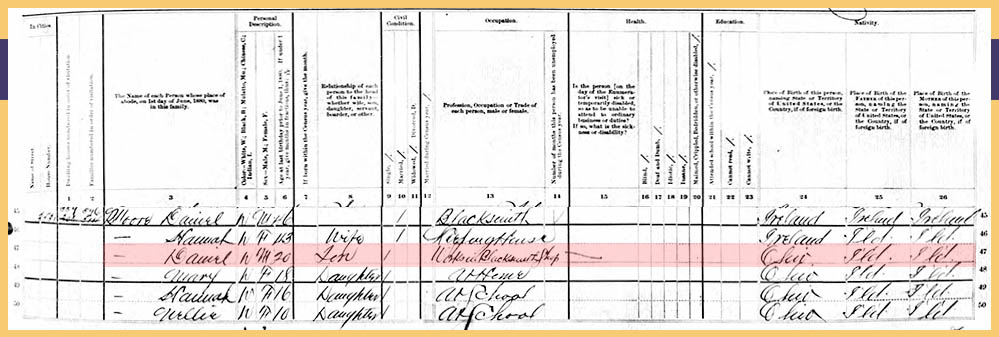
This highlight from the 1880 census shows a 20-year-old Daniel Moore, born around 1860 in Ohio and working as a blacksmith in Chicago. He’s the son of yet another Daniel Moore, also a blacksmith.
My money’s on the death certificate belonging to this guy. He would have been age 31 in 1891 when the death certificate was created.
When you run into a situation where you can’t tell if a document is about your ancestor, research to see if there are other people in the time and place your ancestor lived who have the same/similar name as your person.
Then look to see if any of those people more closely match the document you’re analyzing.
In this case, I’ve found someone who was a better match for the death certificate, which helps rule out the death cert as belonging to Mimi’s Daniel Moore.
Tip 3 — Find out “How do they know?”
You’ll probably come across people claiming many things about your ancestors. Fact about their lives. Documents belonging to them. Online family trees. Stories. Rumors. Pictures. Maybe even heirlooms.
In every case, ask this question: “How do they know?”
How does the person offering the information know that the info is correct?
Before accepting any claim as fact, make sure the sharer has provided documents and/or documentation backing up their claims.
- If there is no documentation, don’t trust the info until you can prove it with documents or DNA.
- If there is documentation, make sure the researcher analyzed the documents correctly (case in point, the death cert studied here).
Digging deeper into Mimi’s historical documents
We’ve debunked Mimi’s claim that the death certificate was for her Daniel Moore. She made several other claims, including these:

“I have several documents,” Mimi writes in this note, “showing” Daniel Moore’s birth date and place, death year, marriage info, and so on.
So, following my own advice, I ask: “How does Mimi really know all these details?”
She has documents.
Except . . . I’ve never seen those historical documents. They haven’t been passed down as this note has. And, after seeing how she analyzed the Daniel Moore death certificate, I question what she “knows” about Daniel Moore.
And that’s the next thing we’ll look at. Until then, have you run across anything similar to this in your family tree? Let me know in the comments!

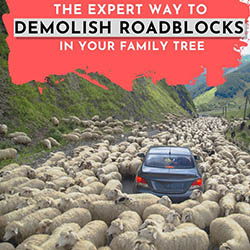
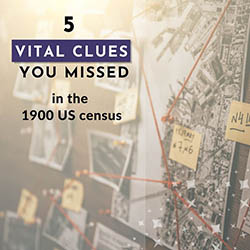
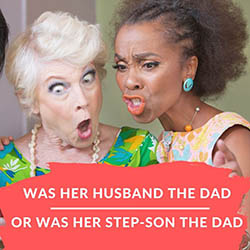

A great example of creative family history in your family and I have one in mine.
My mother used to say there was Indian blood in our family specifically on my father’s side. I asked her where did she get this information and she said: “Grandma Brandon (my father’s mother) used to say quite often “oh that Indian woman” in a very derisive way.
As I worked on the family information I came across death information, ie, death certificate and headstone of the wife of a brother to my grandfather whose name was India Viola. She and her husband, this brother, lived in the same little town in Wyoming as grandma and grandpa. What my grandma was actually saying was “Oh, that India woman” and with my mother’s hearing problem she heard “Oh, that Indian woman.”
I shared that with my mother and we had a good laugh.
Oh, that’s a good one, Marcia! Thanks for sharing that! It’s so interesting how stories can be misheard, misunderstood, misremembered — and translate into somethign very different than what was originally being said. Good for you for finding the truth!